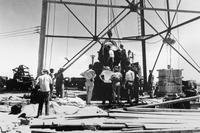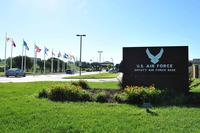The impasse over the deployment of the Marines' MV-22 Ospreys to Okinawa has been caught up in a tangle of ancient territorial disputes across the Western Pacific and fears in the region of an increasingly belligerent China.
In the process, what had been a straight-forward negotiation with Japan over the safety and reliability of the tilt-rotor aircraft has been made more problematic, and 12 Ospreys are still grounded at the Marines' Iwakuni Air Station on the Japanese home island of Honshu where they arrived by sea more than a month ago.
A recent "precautionary landing" in North Carolina, not too far from the site of the Democratic National Convention added more complications to Osprey safety debate in Japan.
On Sept. 6, an Osprey from Marine Medium Tiltrotor Training Squadron 204, based at the New River Air Station in North Carolina, made what the Marines later said was a "precautionary landing" in an empty field behind Fast Freddy's Sports Bar & Grill near Camp Lejeune, N.C.
Neighbors said the Osprey was belching smoke as it came down, and the Marines said the description was "probably accurate," the Jacksonville, N.C., Daily News reported.
The smoke came from "fluid leaking onto hot parts of the aircraft similar to if you spilt oil on a hot lawn mower," said 1st Lt. Kristin Dalton, a New River spokeswoman.
There were no injuries in the incident and the Marines flew the Osprey back to New River early Sept. 8, but not before Japanese reporters and photographers assigned to the Democratic National Convention across the state in Charlotte drove over to cover the latest Osprey mishap.
The timing could not have been worse for the Marines, and for the government of Japanese Prime Minister Yoshihiko Noda.
Japanese media reports on the precautionary landing in North Carolina swelled turnout for a protest by an estimated 100,000 on Okinawa last Saturday against basing as many as 24 Ospreys at the Futenma Marine Air Station.
Okinawa Gov. Hirokazu Nakaima and Atsushi Sakima, the mayor of densely populated Ginowan city which includes the Futenma air base, joined the demonstrators.
Defense Minister Satoshi Morimoto was in Okinawa Tuesday to lobby for the safety of the Ospreys, but the meeting with Nakaima was sidestepping the overriding issues, said Richard Bush, director of the Brooking Institution's Center for Northeast Asian Policy Studies.
"The Okinawans want the Marines out of Okinawa altogether. That's been the problem," Bush said. "And the problem with Futenma is one that's been festering for a long time."
In 2002, the U.S. and Japan agreed to shut down Futenma, but the two governments have yet to agree on an alternate site on Okinawa in the face of local opposition.
"There's a long history of resentment" over the presence of 20,000 Marines on Okinawa, Bush said. No matter what inducements are offered, "you're not going to remove the Okinawan resentment at the U.S. and the central government in Tokyo," Bush said.
Morimoto's pitch to the Okinawans in recent weeks has stressed the value of the Ospreys as a bargaining chip in Japan's increasingly bitter faceoff with China over a few disputed rocky islets in the South China Sea.
"The Osprey deployment is crucial for Japan's security," Morimoto said, stressing that the 300-mile flight from Okinawa to the islands, which Japan calls the Senkakus and China calls the Diaoyu, was easily within range of the Ospreys.
Defense Secretary Leon Panetta and Marine Corps Commandant Gen. James Amos have also played up the enhancement to Japan's security that the Ospreys would provide.
"The Osprey is important to the defense of Japan. It will enable Marines to fly faster and farther from Okinawa to remote islands in Japan. And with the ability to refuel in flight, it can stay aloft much longer. This is a one-of-a-kind platform," Panetta said after meeting with Morimoto at the Pentagon in early August.
The Ospreys and the Senkakus figured in testy exchanges last week between Secretary of State Hillary Clinton and the Chinese in Beijing over the bewildering array of territorial disputes over islands in the East and South China Seas.
China flatly rejected Clinton's push for a "Code of Conduct" to resolve the disputes by negotiation. China's official Xinhua news agency charged that Clinton's trip was "aimed at curbing China's growing influence" in the region and called on Washington to "abandon its surreal ambition of ruling the Asia-Pacific and the world."
The conflicting claims on the islands fueled by growing regional nationalism has overshadowed the work of the U.S.-Japan Joint Committee on resolving safety concerns in Japan about the Osprey, including two recent crashes.
In April, an Osprey crashed on a training mission in Morocco, killing two crew members, and in June an Air Force variant of the Osprey, the CV-22, went down near Eglin Air Force Base in Florida, injuring four.
To ease Japanese concerns, the Marines have offered to restrict Osprey flights over populated areas while noting that there are no similar restrictions on flights over Washington D.C., New York City and other densely populated areas in the U.S.
"There are no unique flight restrictions in the national capital region for the MV-22," the Marines said in a statement. "The aircraft are flown in accordance with Federal Aviation regulations and local traffic patterns that are common to all aircraft operating in the Capital region."
The FAA also deals with the Osprey as with any other military aircraft entering the New York City area, an FAA spokesman said. Panetta's flight to the New York City heliport in Lower Manhattan last year went off without a hitch, although other aircraft at the heliport were moved back to avoid the rotor wash, the spokesman said.
Under the Status of Forces agreement with Japan, the U.S. could unilaterally deploy the Ospreys to Okinawa, but would prefer to gain local acceptance.
At the Pentagon on Monday, chief Pentagon spokesman George Little said the plan was to move the Ospreys from Iwakuni to Futenma later this month, and to have them up and flying in October.
"We are aware of the protests that occurred on Okinawa over the weekend. We believe that the deployment is going to remain on track," Little said.
But then there's the problem of how the Marines will get the Ospreys from Iwakuni to Okinawa. Iwakuni officials are vehemently against flying the Ospreys out of the Marine Air Station and the Marines are just as vehemently against putting the Ospreys back on ships.
"I can't imagine we'd agree to that," a Pentagon official said.
Defense Minister Morimoto and the Marines have offered rides on the Ospreys to Iwakuni officials to demonstrate the aircraft's safety. Thus far there have been no takers.


























